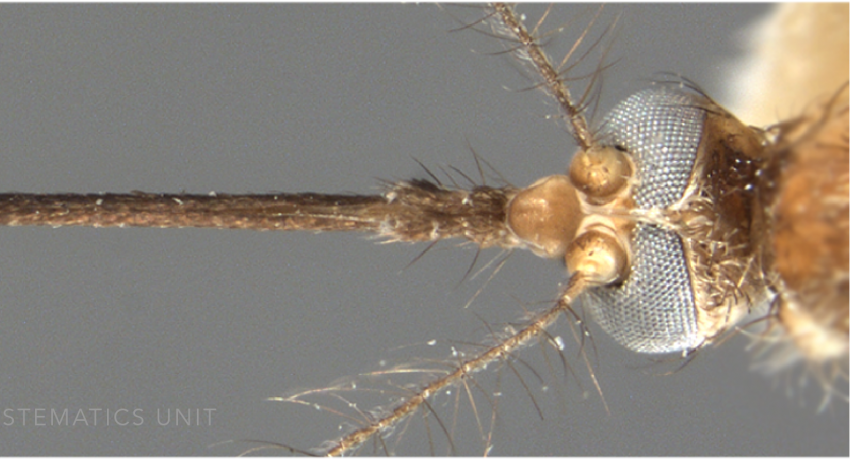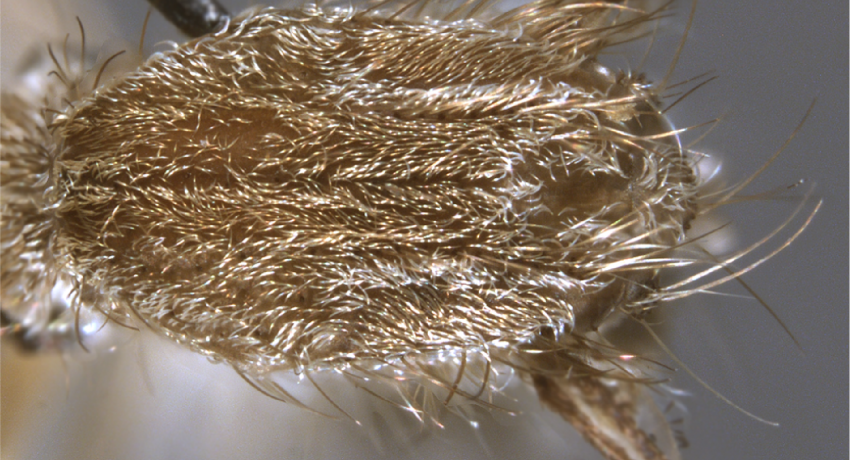NEARCTIC REGION
Etymology: Canada
Aedes canadensis is dark mosquito, with a dusting of white scale patches on the pleuron and distinctly banded hind legs. Two subspecies of Ae. canadensis exist with the topotypic northern population morphologically distinct from its darker subspecies Ae. canadensis mathesoni Middlekauf. This variation in coloration has been attributed to environmental influence, but as both forms exist in sympatry in southeastern United States, these may well represent separate species under further scrutiny. In the United States and Canada, the species is restricted to the eastern seaboard, from northern Florida to Labrador in Canada.
Type locality: Front Creek, near Toronto, Ontario, Canada
Type depository: Natural History Museum, London, England, United Kingdom (NHMUK)
DIAGNOSTIC CHARACTERS (Click photos to view; mouse over and click large photo to zoom in.)
ADULT (illustrated): Head: Proboscis without a pale band; palpus with white-scaled apex, remainder of palpus with scattered pale scales. Thorax: Scutum covered with brown scales; hypostigmal area and postprocoxal membrane bare. Wing: Costa entirely dark basally. Legs: Ta-III5 all white.
LARVA (not illustrated): Head: Antenna (A) spiculate and short, c. 0.5 head length; seta 1-A multi-branched. Thorax: 5-C 4–10 branched; 6-C 3–8 branched; 5–7-C not in a straight line, with 6-C far forward of 5-C; 1-M relatively short, about as long as 3,4-M, not reaching beyond bases of prothoracic setae. Terminal segments: Comb scales in patch, numerous and without apical frill of minute spinules; siphon short, index 2.5–4.0; pecten with evenly spaced spines; anal papillae ≥ length of saddle; saddle incomplete.
TAXONOMIC KEYS
Theobald 1901c: 3 (M*, F*; as Culex)
Carpenter & LaCasse 1955
Dodge 1966
Darsie & Ward 1981
Darsie & Ward 2005
Harrison et al. 2016
Exemplar DNA sequences
Ae. canadensis COI: KM638737, KM937806, KR427986, KR518784, KR715197, KR730530, KR967937, KR969949, MF825957, MG087709, MG242476.
BIONOMICS
Immatures
Typically, Ae. canadensis has one generation per year (univoltine). Eggs deposited at the margins of woodland pools in summer do not hatch until the following spring. In the northern part of its range, eggs hatch in pools formed from melting snow, but some eggs delay hatching until later in the summer or during the fall.
Adults
Adults are long-lived, often being present until late summer, and as a result, adults collected in traps can be almost devoid of scales and are notoriously difficult to identify. Adult females can be nuisance biters, particularly in shaded habitats close to its larval sites. Although known to feed on large and small mammals, (including people), birds and reptiles, Ae. canadensis is highly attracted to turtles. It has been reported feeding on the painted turtle, Chrysemys picta (Schneider), and the box turtle, Terrapine carolina (Linnaeus), and can be seen in clouds around egg-laying females in spring.
DISTRIBUTION NOTES
Canada, Dominican Republic, Mexico, United States (Alaska, continental).

WRBU VECTOR HAZARD REPORTS
None; View other WRBU Vector Hazard Reports
Available GIS Models
Ae_canadensis_Dornak_1 North America
IMPORTANT REFERENCES (full citations below)
Theobald 1901c: 3 (M*, F*; as Culex)
Mitchell 1907 (E*)
Howard et al. 1917 (E)
Craig & Peinkowski 1931 (distribution; Alaska, United States)
Ross 1947: 78 (M*, F*, L*)
Darsie 1951: 20 (P*)
Yamaguti & LaCasse 1951d: 49 (M*, F*, L*)
Carpenter & LaCasse 1955: 161 (M*, F*, L*; keys)
Craig 1956 (E*)
Horsfall & Craig 1956: 372(E*)
Craig & Horsfall 1958 (E*)
Price 1960: 550 (1st instar L*)
Ross & Horsfall 1965 (E*)
Dodge 1966: 350 (1st instar L*; key)
Mohrig 1967 (F*)
Belkin 1968b: 4 (lectotype designation)
Kalpage & Brust 1968 (E*)
Horsfall et al. 1970: 1710 (E*)
Bickley 1981 (taxonomy, distribution; ssp. mathesoni)
Darsie & Ward 1981 (F*, L*; keys, distribution)
Darsie & Ward 2005 (F*, L*; keys, distribution)
Darsie & Ward 2005 (F*, L*; keys, distribution)
Harrison et al. 2016 (F*, L*; keys, distribution; note 14)
CURRENT SYNONYMS
syn. nivitarsis Coquillett
1904c: 168 (M, F; Culex). Type locality: Paterson, New Jersey, United States (USNM). References: Stone & Knight 1956a: 222 (type information, lectotype designation).
ssp. mathesoni Middlekauff
1944: 42 (M*, F; as Aedes sp.). Type locality: Kissimmee, Florida, United States (USNM). Distribution: Canada, United States (continental). References: Rings & Hill 1946: 237 (L*); Rings & Hill 1948: 41 (F*; tax., to ssp.); Yamaguti & LaCasse 1951d: 128 (M*, F*, L*); Carpenter & LaCasse 1955 (keys); Pickavance et al. 1970 (distribution); Bickley 1981 (taxonomy, distribution; ssp. mathesoni); Darsie & Ward 1981 (F*, L*; keys, distribution); Darsie & Ward 2005 (F*, L*; keys, distribution); Darsie & Ward 2005 (F*, L*; keys, distribution); Harrison et al. 2016 (F*, L*; keys, distribution). Etymology: Robert Matheson.
CITED REFERENCES
Belkin, J.N. (1968b). Mosquito studies (Diptera, Culicidae). IX. The type specimens of New World mosquitoes in European museums. Contributions of the American Entomological Institute, 3(4), 1–69
Bickley, W.E. (1981). Notes on the geographical distribution of Aedes canadensis mathesoni. Mosquito Systematics, 13(2), 150–152.
Carpenter, S.J., & LaCasse, W.J. (1955). Mosquitoes of North America (North of Mexico). Berkeley, Los Angeles: University of California Press.
Craig Jr., G.B. (1956). Classification of eggs of nearctic Aedinae mosquitoes (Diptera: Culicidae). Dissertation Abstract (5).
Craig Jr., G.B., & Horsfall, W.R. (1958). Taxonomic and ecological significance of eggs of aedine mosquitoes. Proceeding of the Tenth International Congress of Entomology, 3, 853–857.
Craig Jr., G.B., & Peinkowski, R.L. (1931). The occurrence of Aedes canadensis (Theobald) in Alaska (Diptera, Culicidae). Proceedings of the Entomological Society of Washington, 57(6), 268.
Darsie, R.F., Jr. (1951). Pupae of the culicine mosquitoes of the northeastern United States (Diptera, Culicidae, Culicini). Ithaca, NY: Cornell University Agricultural Experiment Station Memoir 304.
Darsie, R.F., Jr., & Ward, R.A. (1981). Identification and geographical distribution of the mosquitoes of North America, north of Mexico. Mosquito Systematics Supplement, Supplement 1, 1–313.
Darsie, R.F., Jr., & Ward, R.A. (2005). Identification and geographical distribution of the mosquitoes of North America, north of Mexico. Gainesville, FL: University Press of Florida.
Dodge, H. R. (1966). Studies on mosquito larvae II. The first-stage larvae of North American Culicidae and of world Anophelinae. Canadian Entomologist, 98, 337–393.
Harrison, B.A., Byrd, B.D., Sither, C.B., & Whitt, P.B. (2016). The mosquitoes of the Mid-Atlantic Region: an identification guide (Vol. 1). Madison Heights, MI: Publishing XPress.
Horsfall, W.R., & Craig, G.B. Jr. (1956). Eggs of floodwater mosquitoes IV. Species of Aedes common in Illinois. (Diptera: Culicidae). Annals of the Entomological Society of America, 49(4), 368–374.
Horsfall, W.R., Voorhees, F.R., & Cupp, E.W. (1970). Eggs of floodwater mosquitoes. XIII. Chorionic sculpturing. Annals of the Entomological Society of America, 63, 1709–1716.
Howard, L.O., Dyar, H.G., & Knab, F. (1917). The mosquitoes of North and Central America and the West Indies. Systematic description. Part II. Carnegie Institute of Washington.
Kalpage, K.S., & Brust, R.A. (1968). Mosquitoes of Manitoba. 1. Descriptions and a key to Aedes eggs (Diptera: Culicidae). Canadian Journal of Zoology, 699–718.
Middlekauff, W.W. (1944). A new species of Aedes from Florida (Diptera: Culicidae). Proceedings of the Entomological Society of Washington, 46, 42–44.
Mitchell, E.G. (1907). The classification of the Culicidae. Canadian Entomologist, 198–201.
Mohrig, W. (1967). Die taxonomische Bedeutung der Struktur weiblicher Genitalien im Culiciden- Tribus Aedini. Angewandte Parasitologie, 8, 67–100.
Pickavance, J.R., Bennett, G.F., & Phipps., J. (1970). Some mosquitoes and blackflies from Newfoundland. Canadian Journal of Research, 48, 621–624.
Price, R.D. (1960). Identification of first-instar aedine mosquito larvae of Minnesota (Diptera: Culicidae). Canadian Entomologist, 92, 544–560.
Rings, R. W., & Hill, S. O. (1946). The larva of Aedes (Ochlerotatus) mathesoni Middlekauff (Diptera, Culicidae). Proceedings of the Entomological Society of Washington, 48, 237–240.
Rings, R. W., & Hill, S. O. (1948). The taxonomic status of Aedes mathesoni (Diptera, Culicidae). Proceedings of the Entomological Society of Washington, 50, 41–49.
Ross, H.H. (1947). The mosquitoes of Illinois (Diptera, Culicidae). Bulletin of the Illinois Natural History Survey, 24(1), 1–96.
Ross, H.H., & Horsfall, W.R. (1965). A synopsis of the mosquitoes of Illinois (Diptera, Culicidae). Illinois Natural History Survey Biological Notes, 52, 1–50.
Theobald, F.V. (1901c). A monograph of the Culicidae or mosquitoes (Vol. 2). London: British Museum (Natural History). with Atlas of 37 colored pls. + 5 pls. of photographs.
Yamaguti, S., & LaCasse, W.J. (1951d). Mosquito fauna of North America Part V – Genus Aedes. Office of the Surgeon, Headquarters, 8th Army, APO 343. United States. Office of the Surgeon-General. 207th Malaria Survey Detachment.
CITE THIS PAGE
Walter Reed Biosystematics Unit (Year). Aedes canadensis species page. Walter Reed Biosystematics Unit Website, http://wrbu.si.edu/vectorspecies/mosquitoes/canadensis, accessed on [date (e.g. 03 February 2020) when you last viewed the site].











































































































































































